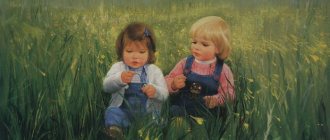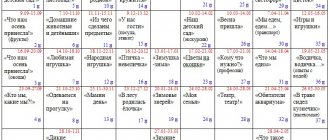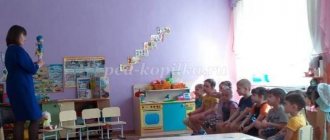Planning lessons on traffic rules in the middle group
Drawing up long-term plans is regularly carried out in preschool institutions. Teachers prepare notes for each event, approved by methodologists.
The daily routine in a preschool institution for children in the middle group should be designed in such a way that no more than 25 minutes are devoted to one lesson. The entire period of time is divided into four stages:
- Introductory is the beginning of a lesson that should attract the attention of the children and show the relevance of the topic. You can start the lesson by reading a short story, showing a picture, illustration, or the arrival of a fairy-tale hero.
- No more than 10 minutes are allocated for the central stage of the lesson. It includes a detailed examination of the topic, consolidation of existing knowledge. The main part may include physical education and gymnastics.
- 7 minutes are allocated in the third part of the lesson to consolidate the material received. Children must organize information. It is played out using various educational techniques.
- At the final stage, the teacher evaluates the activity.
Planning annual activities
In order to understand whether the lesson objectives have been achieved, a detailed analysis must be carried out. It is divided into two types:
- introspection;
- analysis of those present.
Plan of educational work according to the Federal State Educational Standard
The first type refers to the independent preparation of a report by the teacher. In the second case, a methodologist comes to the lesson and carries out an analysis based on the results.
If an open session was held, a group analysis may be given. Most often it consists of an oral discussion.
Long-term planning of work on traffic rules in the middle group.
Transcript
1 Long-term planning of work on traffic rules in the middle group. Goal: To develop safe behavior skills in children on the streets and roads. Tasks. Educational areas Physical development: - introduce the rules of behavior on the street when crossing roads and intersections; — introduce children to the concepts: “roadway”, “pedestrian”, “one-way and two-way traffic”, “ground (underground) passage”; - promote the development of coordination and orientation in space. Social communicative development: - ensure the assimilation of the rules of safe behavior on the street; - promote the joint participation of boys and girls in role-playing, didactic and other types of games. Cognitive development: - clarify knowledge about the purpose of a traffic light; — introduce more broadly and in-depth information about transport and teach proper behavior on the street; — to form primary ideas about the work of a driver; - distinguish not only directions (forward back, up down, right to left), but also move in the indicated direction; - to form generalized ideas about the objects being constructed, to master these structures both from models and in the process of their independent transformation by children according to given conditions;
2 - provide opportunities, while experimenting with new materials (such as Lego), to discover fastening methods and create simple buildings for the game; — help master two new ways of design by folding a square sheet of paper diagonally and in half, aligning opposite sides and corners; — learn to make simple crafts based on these methods. Speech development: - enrich and activate vocabulary in the process of expanding ideas about the world around us and enriching the themes of children’s communication with adults and peers, organizing observations, looking at pictures, objects, etc. - learn to understand the meaning of riddles. Artistic and aesthetic development: - develop the ability to listen to literary works of various genres: fairy tales, short stories, poems, riddles. - develop productive activities (drawing, appliqué). Block Forms of work September October November Activities with children Walk “Getting to know the street” 1. Goal: to expand children’s understanding of the street (houses on the street have different purposes: people live in some, shops, schools, post offices, etc. are located in others .; cars move along the roadway of the street; the movement of cars can be one-way or two-way; driving Observation of cars. Purpose: to teach to distinguish cars by their purpose; to form an interest in the profession of a driver, the desire to master his work actions. Observation of the work of a driver. Purpose: continue to shape children’s understanding of the work of a driver; cultivate interest and respect for the work of adults.
Part 3 of the street in two-way traffic can be divided by a line). 2. Goal: to introduce children to some rules for the movement of pedestrians on the street, with the concepts: “pedestrian”, “crossing”. GCD Thematic week “City Street”. "On the city streets." Goals. Familiarize yourself with public transport and its travel rules. Teach the rules of crossing the street using an overpass. "Houses on our street." - construction of a house from building material according to a sample. Development of speech “Urban transport”. Target. Clarify ideas about urban transport, consolidate the general word “transport”. Application “Bus with colored “Cars are assistants to people.” Target. Talk about how machines are assistants to people; introduce the parts of the machine and its purpose. Modeling "Cargo for the car." Target. Learn to sculpt a load for a car. FEMP 4 “Gate” Goal. Exercise in the construction of buildings with ceilings. “The driver doesn’t like to sleep for a long time.” Target. To deepen children’s understanding of the labor actions of a “Garage” driver, a garage made of building material.
4 Thematic day Fiction. Conversation. Games (moving, didactic, role-playing and board games). windows." Target. Continue to master the technique of folding paper in half and the ability to use scissors. — Teach the rules of safe behavior in the kindergarten area. Discuss with the children which places on the kindergarten site may pose a danger (gates, entrance for cars, etc.). - Reading S. Mikhalkov “My Street”. — Acting out situations on a model city that teach the monkey Anfisa to cross the road. — Games with homemade buses on a “model” of the city. — introduce the basic rules of safe behavior on the street when crossing the roadway. — Reading the story by M. Ilyin, E. Segal “Cars on our street.” - Reading by S. Mikhalkov “Uncle Styopa the Policeman”, fairy tales by E. Uspensky and V. Chizhikov “Vera and Anfisa got lost.” — Riddles about transport. — Sub/games “Cars”, “Tram”, “Colored Cars”. — Did/game “Pick up the load to the car.” — Games with Lego constructor. Traffic Light Day. — exhibition of handicrafts “Red, Yellow, Green” and drawings. — Conversation “Who brings food to the kindergarten”, “What do we drive around the city.” — Reading “Truck” by A. Barto. — Learning the poem “Traffic Light” by S. Marshak. — Sub/games “Planes”, “Colored Cars”, “Tram”. — Role-playing game “Chauffeurs.” — Did/game “What do people drive?” — Did/game “Loto”.
5 Subject-based development environment. Working with parents. Thematic exhibition. Consultation. Parent meeting. — Sub/games “Cars”, “Planes”. — Role-playing game “Family”. “City layout”, illustrations, pictures depicting a city street. Poster Traffic rules. Book by S. Mikhalkov “Uncle Styopa the Policeman”. Accordion folder - Consultation for parents “The baby should know this.” (Traffic Laws). — Parents’ meeting “Tasks of raising children in the middle group.” Traffic corner (city model, books, illustrations and pictures about transport, a set of cars, a “Transport” construction set, steering wheels). Road signs. Crafts based on traffic rules from the exhibition “Red”, “Yellow”, “Green”. Toy cars, traffic lights, cargo. Puzzles "Transport". - Make an exhibition of crafts according to traffic rules and ask parents to take part in the exhibition of crafts “Red”, “Yellow”, “Green”. — Exhibition of crafts and drawings “Red”, “Yellow”, “Green”. Block Forms of work December January February Observation of machines Observation of Goal: to expand knowledge about air transport and ground transport (their Goal: to expand knowledge about classification, purpose). Air travel, its activities with children. GCD for use and purpose. “Ships and planes” made from Lego parts.
6 Subject-based development environment Work with parents Independent artistic activity of children Fiction. Conversation. Games (moving, didactic, role-playing and board games). Advice to parents, making a request. — Teacher’s story “How firefighters work.” — Conversation “What they carry and how different machines work.” — Did/game “Describe and name.” — Role-playing game “Colored Cars”, “Tram”. “What do people drive?” Sub/game: “Announcing stops” Set of pictures “Ground transport”. Design of visual campaigning with tips for parents. Drawing "Car with a load." - Conversation “To make the car go” - Reading V. Berestov “About the car.” — Did/game “What does the traffic light say?” — Role-playing game “Transport.” — Sub/games: “Cars”, “Colored cars”, “Sleigh train”. Toys: “Fire truck”, “Police”, telephone. Ask parents: “Draw children’s attention to the traffic light when crossing the road.” Purpose: monitoring the operation of the traffic light. Drawing "Fire Truck". Transport coloring pages. — Conversations “Planes, helicopters”, “Our friend the traffic light”. — Did/game and exercise: “Air transport.” — Sub/game “Sparrows and the car.” Sub/games: - “Airplanes” Set of pictures “Air transport”. Drawing according to children's ideas. Block Forms of work March April May Observation of labor Observation
7 Activities with children Walking with harvesting machines Purpose: to expand knowledge about the role of machines in performing labor-intensive work, the features of their structure; cultivate interest in technology and respect for the work of adults. driver Goal: to continue to get acquainted with the work of a driver, the names of parts of the car. Activities Thematic week. Transport. Careful road. “Why are road signs needed?” Purpose. Strengthen children's knowledge about the rules of behavior on the street; about road signs. FEMP 15 “Car house”, a house made of building material. fiction. Reading A. Sedugina’s fairy tale “Conversation of Machines.” Goal: To teach students to listen carefully to the text, reason, and express their point FEMP 13 “Trams” made from building material and Lego. "Summer Travels" Target. Introduce the professions of a driver and conductor. Teach rules of behavior on the train. "Bridge" made of building material.
8 Subject-based development environment Work with parents Exhibition Fiction. Conversation. Games (moving, didactic, role-playing and board games). Questionnaire for parents. Leisure “Respect the traffic light.” vision. D/V 1989 “My Car” exhibition of children’s favorite cars. — Discussion with children about the rules of safe behavior on the train, train, train station and railway station. — The story of the teacher “Ambulance”. — Poems, riddles about transport. — Role-playing games: “Whose car?” "Bus". — Game exercise “You entered the bus”, — Sub/game “Airplanes” Road signs, lapel and portable. Leisure “Respect the traffic light.” Participation in the exhibition “My Car”. Exhibition of children's drawings "Green Light". — A conversation about how to behave while riding a bicycle or scooter. — Reading: V. Klimenko “Bunny Cyclist”, “Travel with Toys”. — Story-based role-playing game “Journey around the city.” - "Domino". — Sub/game “Sparrows and the car.” Illustrations depicting different buildings (school, shopping center, theater, cinema, museum). Replenish the traffic corner with gaming materials and games. — Conversation “How to behave in transport.” — Conversation “How did you go to the forest.” — Did/games: “What I travel on,” “Traffic rules,” “My friend the traffic light.” — Role-playing games: “Transport”. — Sub/game “Airplanes”. Did/game “Traffic Light”. Pictures, illustrations depicting different types of railway transport. Questionnaire for parents “Rules for safe behavior of children on the streets and roads.”
9 Literature. 1. We study the road alphabet. Long-term planning. Classes. Leisure. F.S. Mayorova. "Scriptorium Publishing House", Traffic Rules. Middle group. L.B. Poddubnaya. Volgograd: ITD “Corypheus”, Walks in kindergarten. Junior and middle groups. I.V. Kravchenko, T.L. Dolgova: Methodological manual. M:, Sphere shopping center, Developmental activities for children 4-5 years old. L.A. Paramonova. M: OLMA Media Group, Long-term planning of the educational process in a preschool institution. Middle group. I.S. Golitsyna M: “Publishing house Scriptorium 2003”, Federal State Educational Standard for Preschool Education. 7. Educational program of the preschool educational institution. 8. Physical education in kindergarten: Middle group. Penzulaeva L. I. M: MOSAIC-SYNTHESIS, The world around us in didactic games for preschoolers. L.V. Artemova. M: Education, Comprehensive thematic planning of the educational process with children 4-5 years old. Vasyukova N. E., Rodina N. M. M.: Sphere shopping center, Introducing preschoolers to the rules of the road. Saulina T.F. M.: MOSAIC-SYNTHESIS, 2014.
Types of activities
The process of developing knowledge about traffic rules in children in the middle group can be carried out through the use of various types of activities, didactic material, illustrations, fiction, and multimedia applications.
Introducing your child to road signs
The objectives of the classes, both in a long-term project and during a short-term period of familiarization with the topic, are:
- Introduce children to the meanings of traffic lights, expanding existing ideas.
- Introduction to modes of transport.
- Providing knowledge about the street, sidewalk, roadway.
- Familiarity with the basic rules of the road.
- Fostering a culture of behavior in transport and on the street.
Mastering the basics of safety is the daily work of both teachers and parents. To achieve the set goals, any available forms and methods of interaction can be used, both in the form of entertainment and educational activities.
Conducting a conversation at a preschool educational institution
Short term projects
All classes conducted in preschool institutions comply with pre-drawn plans. Short-term projects are carried out as regular activities aimed at studying traffic rules. They may be dedicated to certain holidays. Most often, parents are involved in participation.
The projects involve holding exhibitions. For example, children, together with their parents, make models of roads, traffic lights, and pedestrian crossings at home. A city or regional work competition may be organized.
A short-term project can be a group activity in which children create a collage of appliques, drawings or crafts around a theme.
This method allows not only to consolidate the acquired knowledge about transport and road signs, but also to show creativity.
Organization of exhibitions on traffic rules
Conversations
Conversing with preschoolers in kindergartens is one of the most common forms of acquiring knowledge. It can be carried out both in the morning circle and in extracurricular activities, for example, on a walk. Any trip to the theater, museum or library can be compared to a conversation about traffic rules, when the teacher uses live examples to tell the child about behavior on the road.
Fiction and its reading in older groups - card index
Additional Information! This type of educational activity such as conversation should be carried out comprehensively. Parents play an important role in this situation. The task of educators is to explain to parents the meaning of their conversations with their children.
Open classes
Open classes can be held in various forms. These could be theatrical performances in which the children themselves take part, or inviting representatives of the traffic police to conduct a lesson.
The objectives of the classes are:
- expanding children's understanding of the street, sidewalk, roadway;
- familiarization with the concept of pedestrian crossings, traffic lights, rules of use.
During the classes, the children not only acquire new knowledge and consolidate existing knowledge, but also develop a desire to help others on the road.
Form of open classes
Integrated classes
An integrated lesson means a combination of different types of activities in a certain period of time. For example, holding a quiz after watching a play or reading a story about traffic rules.
The lesson can be structured as follows. The fairy-tale hero Traffic Light will come to the children and tell him about his friend the dog, who ran across the road at the wrong red light. The traffic light will tell the kids that the car didn’t have time to stop and ran over the dog’s paw. He is now in the hospital. After this, you can conduct a drawing lesson, ask the children to draw drawings for the dog, which will reflect the rules on how to cross the roadway correctly.
Traffic rules week
According to the standards of the Federal State Educational Standard for preschool education, social and communicative development should be aimed at mastering the basic values and safety standards accepted in society. It is recommended to divide the educational process into thematic weeks.
A separate week should also be devoted to studying traffic rules, which includes complex activities. These could be combined open lessons, organizing meetings with traffic police officers, quizzes, and theatrical skits. In parallel, work should be carried out with parents.
Note! Classes can be conducted both collectively and individually. The variety of methods makes it possible for each child to find exactly what is more understandable to him. If a child does not like to draw, but listens to stories with great pleasure, he will better perceive information during conversations and reading fiction.


